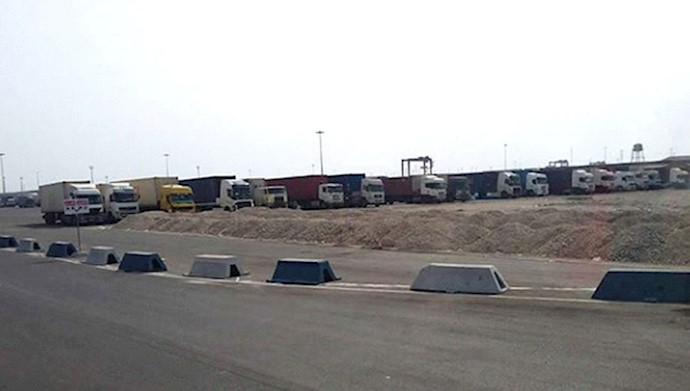Reported by PMOI/MEK
Iran, Dec. 25, 2018 – On Saturday, December 22, truck drivers across Iran began the fifth round of their nationwide strikes. Contrary to the previous four rounds, which were unlimited, the newest strike has been organized and predetermined to be 10 days in duration.
After four rounds of strikes, the truck drivers of Iran are now more organized and experienced in carrying out their protests to achieve their demands. The truckers have been protesting against rising prices, decreasing wages, unfair policies by government institutions and lack of responsiveness from Iranian officials.
The newest strike by truck drivers began while the majority of drivers had stopped working in previous days and were effectively on strike. None of the promises made by government officials have been fulfilled and the problems of the drivers remain unsolved, which has pushed them to continue their strikes.
Five rounds of strikes by Iran’s truckers
Since the beginning of the year, Iran’s truckers have gone on strike on five separate occasions:
- In May, the first round of strikes by truck drivers began and quickly spread to hundreds of cities
- In July, the truckers began the second round of their strikes. More than 300 cities joined the strikes.
- The third round of strikes by Iran’s truck drivers took place in late October and lasted for 10 days. Again, drivers from 300 Iranian cities joined the strikes.
- The fourth round took place shortly after, in early November, and garnered the support and participation of truck drivers from dozens of Iranian cities.
- The fifth round of strikes by truck drivers began on December 22 and will continue until the turn of the year.
The first round of strikes by Iran’s truck drivers
The first round of strikes began on May 22. On June 8, the strike met complications due to the deceitful promises made by Iranian authorities. News of the strikes was also eclipsed by other events such as the World Cup soccer games in Russia. While the achievements of this first round of strikes was very little, it set the stage for the second round of truckers’ strikes, which came in the summer.
The second round of strikes
Iran’s truck drivers went on strike for the second time this year on July 23. The second round of strikes turned into popular demonstrations in Isfahan’s Shapur city. The strikes blended into the third round of nationwide protests that took place following the December uprisings.
In tandem with the strikes, there were ongoing protests by the Iranian people in various cities, most notably in Isfahan, Karaj, Shiraz, and Rasht.
The strikes gradually subsided after August 11, but they played a significant role in sparking popular protests across the country and encouraging the deprived people of Iran, of all walks of life, to rise and take to the streets to reclaim their rights.
The environment caused by the ongoing strikes also helped shape the protests of workers, especially the strikes and protests by the workers of Haft Tapeh sugarcane company and the steelworkers of Ahvaz’s Iran National Steel Industrial Group. The coordination and solidarity of the truck drivers helped other communities better organize their own demonstrations and strikes.
The increased coordination in the strikes and protests helped highlight the fundamental demand of the Iranian people, which is the overthrow of the mullahs’ regime and its replacement with a democratic state. As calls for the downfall of the regime became more and more accentuated in protests, the allies of the Iranian regime who were hiding behind a pretense of opposition were forced to reveal their true nature and to show where their loyalties lay. These so-called opposition forces explicitly admitted that they were not in favor of regime change and wanted to preserve the current regime.
The third round of strikes by Iran’s truck drivers
On August 25, truck drivers across Iran went on strike for the third time. This time, the drivers expanded their activities to demonstrations in front of governors’ offices in several provinces. They also established strong bonds with different communities and enjoyed vast support from people across Iran.
The fourth round of strikes by Iran’s truck drivers
On September 22, the fourth round of strikes by Iranian truckers started. On its fifth day, the strike had already reached more than 200 cities across Iran. Despite the many political developments that were happening at the same time and the regime’s efforts to prevent attention from being brought to the strikes, the truck drivers managed to keep their movement and protests alive.
The fifth round of strikes by Iran’s truck drivers
Iran’s truck drivers are now in the midst of the fifth round of their nationwide strikes. Their strikes are backed by the experience they’ve gained from the four previous rounds. They’re also disillusioned about the Iranian regime’s insincerity in responding to their demands.
They’ve observed and learned from recent strikes and protests by the workers of Haft Tapeh Sugar Factory and Ahvaz Steel Company. They’ve had the first-hand experience with the deceitful policies and rhetoric of the regime’s parliament and its institutions and officials.
So far, the drivers have proven that they have the power and potential to create momentum for nationwide protests and can rally other communities and walks of life around a common cause to defy and confront the dictatorship ruling their country.
The past seven months have shown that the hardworking people of Iran can achieve unity and take great strides toward achieving their rights and their demands. And of course, as we move forward, it becomes clear to everyone that the demands of the Iranian people will only be met when the tyrannical rule of the mullahs comes to its inevitable end.





